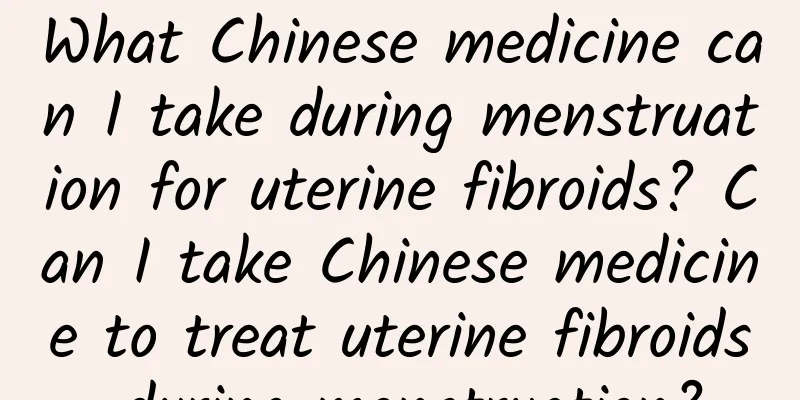How to regulate blood clots during menstruation? Four methods are recommended

|
During menstruation, most people's menstruation is normal red, but there are a small number of female friends who are different. They always have dark red, dark purple, brown, or black blood clots during menstruation. So what causes this situation? Let's learn about the treatment methods for blood clots during menstruation. Causes of blood clots during menstruation Most menstrual periods are 3 to 5 days, with a normal range of 2 to 7 days, and an average total amount of bleeding of about 50 ml. Under normal circumstances, menstruation is bright red, without dark purple blood clots. Once menstruation with blood clots occurs, it is often accompanied by dysmenorrhea. The following are the causes of menstrual blood clots: 1. It is related to the amount of bleeding and the speed of bleeding. If the bleeding is heavy and the speed is fast, there is often the possibility of blood clots. At this time, the amount of bleeding is relatively large and it will accumulate into a clot. 2. It is a common symptom of irregular menstruation. Blood clots during menstruation are mostly bleeding symptoms caused by the shedding of the endometrium in women. 3. The reason for blood clots during menstruation may be that the Qi and blood of the whole body are not strong and the downward flow is not smooth, so the menstrual volume is relatively small. If the color is darker or there are clots, it means that the cold Qi in the body is too heavy. 4. It may also be due to liver qi stagnation. The more blood clots there are, the more severe the meridian blockage is, which can be solved through massage. Is it normal to have blood clots during menstruation? As long as the total amount of bleeding does not exceed the standard, it is basically normal. The speed of menstrual bleeding has no effect on health. It is just the difference between "more every day but ends in 3 days" and "less every day but ends in 7 days". This is the normal difference in each person's physique, coagulation function, etc. Therefore, women do not need to worry about blood clots affecting their health. Be careful if large blood clots appear Menstruation with blood clots is regulated by the hypothalamus-pituitary-ovarian axis and undergoes periodic changes. The shed endometrium and blood mix together to form menstrual blood. If there is a large amount of endometrium shedding, there will be blood clots, which is a normal physiological phenomenon. However, if the endometrium is infected, there will be increased bleeding and abdominal pain. If you have large blood clots, your clothes and bed sheets are often soiled, you have to use extra-large sanitary napkins, and you feel dizzy, it means you have too much menstrual blood. If you don't ovulate and your menstrual flow is too little or it hasn't come for too long, the endometrium will not be completely shed, so it becomes very thick and unstable, and when it sheds, it will form a large amount of menstrual blood. If you bleed a lot in an instant, your body will definitely not be able to support it, and you may faint, which is very dangerous. If you have excessive menstrual flow for a long time and the condition becomes more serious with age, you should consider whether you have uterine fibroids, uterine adenomas or abnormal blood coagulation function. When uterine fibroids grow in the uterine cavity or close to the endometrium, it will cause excessive menstrual bleeding. How should it be adjusted? 1. You can use Chinese medicine for conditioning According to the signs and symptoms, you can use methods to promote blood circulation and remove blood stasis, regulate qi and dredge collaterals, such as eating safflower, peach kernel, mint, Kuncao, Ze Lan, red peony root, etc., which will have good effects and efficacy. If the menstrual blood is not only dark red, but also has blood clots, this is a "blood stasis and qi stagnation" constitution, which can be regulated with Chuanxiong, Danshen, safflower, etc. If the menstrual blood is less and light in color, it is "blood deficiency and physical weakness", and you should use angelica, astragalus, cooked rehmannia, longan and ginseng to replenish the body. But be careful to take it under the guidance of a doctor. 2. Women who have blood clots during menstruation should pay attention to menstrual protection Do not eat raw or cold food; keep warm in winter and avoid catching cold; maintain a happy mood, do not overwork, and know how to combine work and rest. 3. Improve conditioning through diet Women can eat high-protein, low-fat foods, take in more vitamins C and E to facilitate pelvic blood circulation, and supplement with calcium and magnesium to relax their muscles. 4. From the 3 days before menstruation to the end of menstruation, the food you eat should be warm Eat less grilled, fried, spicy or pickled food, avoid watermelon, pear, coconut, grapefruit, to avoid affecting blood vessel contraction. Cabbage, bitter gourd, and white radish should also be heated before eating. The above is the treatment method for female friends when they have blood clots during menstruation. In fact, women should still pay attention to it every time they have menstruation. Don't blindly indulge in enjoyment and let your body suffer. If it is only a small amount of blood clots during menstruation, and the color is not very abnormal, there is no need to make a fuss. Experts remind: female friends should have a reasonable diet and a reasonable rest time. |
>>: Can you do color Doppler ultrasound during menstruation? These analyses will tell you
Recommend
Two major factors related to the cause of ectopic pregnancy
Ectopic pregnancy is a disease that is very harmf...
Precautions after uterine fibroid surgery
Uterine fibroids are the most common benign tumor...
What to do if your menstrual flow is light and dark
What should I do if my menstrual flow is light an...
What are the effects of acute pelvic inflammatory disease?
What are the effects of acute pelvic inflammatory...
Can I drink motherwort granules during menstruation?
You can drink Motherwort granules during menstrua...
What causes low back pain in adenomyosis?
What is adenomyosis? 1. Low back pain may be a sy...
Will medical abortion cause infertility?
Will medical abortion cause infertility? 1. If yo...
What is the reason for irregular menstruation and fear of cold?
What is the reason for irregular menstruation and...
How much does it cost to treat endometrial thickening?
How much does it cost to treat endometrial thicke...
How to relieve women's dysmenorrhea
Dysmenorrhea is a common disease that will have a...
Symptoms and treatment of chronic pelvic inflammatory disease
Symptoms and treatment of chronic pelvic inflamma...
Wearing tight pants for a long time can easily induce vaginitis
Tight pants seem to have a magical power that can...
Signs of bacterial vaginosis
Do you think there is only one type of bacterial ...
How to use topical medications for chronic cervicitis in women? Medication guide for patients with chronic cervicitis
Chronic cervicitis can be treated with topical me...
The secret of preventing and treating hyperprolactinemia
Many friends at work rarely have time to pay atte...









